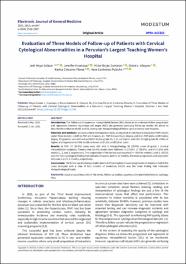Evaluation of Three Models of Follow-up of Patients with Cervical Cytological Abnormalities in a Peruvian’s Largest Teaching Women’s Hospital

Ver/
Descargar
(application/pdf: 380.0Kb)
(application/pdf: 380.0Kb)
Fecha
2022-01-13Autor(es)
Moya-Salazar, Jeel
Huarcaya, Jennifer
Rojas-Zumaran, Víctor
Vásquez, Diana L.
Chicoma-Flores, Karina
Contreras-Pulache, Hans
Metadatos
Mostrar el registro completo del ítemResumen
“Introduction: The follow-up of squamous intraepithelial lesions (SIL) allows us to understand their progression and regression, however squamous cell atypia (ASC) can generate confusing follow-up results. We aimed to describe the evolution of ASC and SIL during cyto-histopathological follow-up in a tertiary-care hospital.
Materials and methods: we conducted a retrospective study during 2016 in 156 Papanicolaou test (PAP) results under three models: 1) with ≥1 PAP and biopsies, 2) 1 PAP followed by ≥1 biopsy, and 3) ≥1 PAP and a confirmatory biopsy. Progression was defined as ASCUS to low-grade SIL (LSIL) or higher, and LSIL to high-grade SIL (HSIL) or higher; and regression as HSIL to LSIL or lower; and LSIL to ASCUS or lower.
Results: In PAP, 57 (36.5%) cases were ASC and in histopathology 56 (39.9%) cases of grade 1 cervical intraepithelial neoplasia. Twenty-nine (18.6%) results were followed: 8 (27.6%), 17 (58.6%), and 4 (13.8%) with models 1, 2, and 3, respectively. The progression of the lesions was reported in ~50% for models 2 and 3. ASCUS was the main cytological finding that indicated biopsies, and for all models, the mean progression and regression time was 4 and 3.1 months, respectively.
Conclusions: The follow-up of cytological alterations in three models showed progression of lesions in half of the cases analyzed with a time of four months of evolution; ASCUS was the main finding that indicated histopathological study.“
Palabras clave
Colecciones
- Web of Science (WOS) [236]

